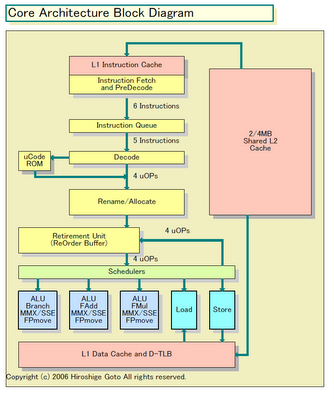Saturday, June 17, 2006
Intel's versus AMD's microarchitecture
| L1 Cache | Instructions - 32KB Data - 32KB | Instructions - 64KB Data - 64KB |
| L1 Cache Latency | 3 Cycles | 3 Cycles |
| L1 Associativity | 8-way | 2-way |
| L1 TLB | Instructions - 128 Entries Data - 256 Entries | Instructions - 32 Entries Data - 32 Entries |
| L2 Cache | Max 4MB | Max 1MB |
| L2 Cache Latency | 12 Cycles | 12-14 Cycles |
| L2 Associativity | 16 Way | 16 Way |
| L2 Bandwidth | 256Bit | 128Bit |
| L2 TLB | n/a | 512 Entries |
| Memory Controller | External | Internal |
| Pipeline Stage | 14 | 12 |
| Branch Predictor Bandwitdh | 20Bytes | 16Bytes |
| Decode to Execute Unit | 3 Simple + 1 Complex | 3 Complex |
| FPU | 1FMUL + and 1 FADD + 1 FStore + 1 FLoad | 1FMUL + and 1 FADD + 1 FStore |
| Integer Unit | 3 Int + 2 AGU | 3 Int + 3 AGU |
| Load/Store | 1 Load + 1 Store | 1 Load & Store |
| ALU | 3 | 3 |
| SSE Unit | 3 - 128Bit | 2 - 64Bit |
FP Unit | 2 | 2 |
64 bit microarchitecture differences in addition. So much about Intel's "new" microarchitecture advantage over AMD's old proven one.

This post link


